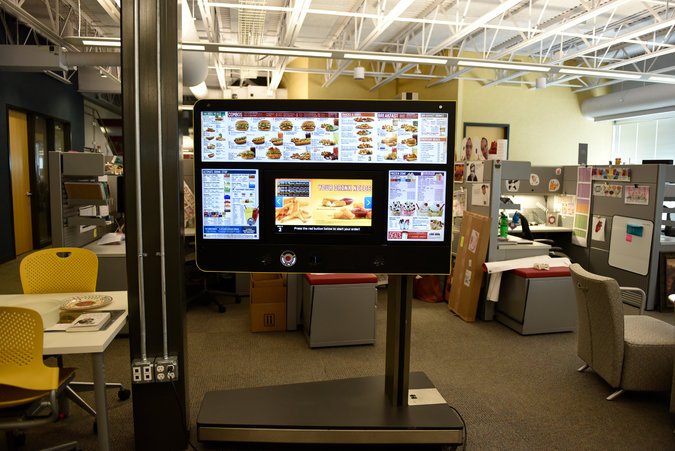That lesson has helped shape Mr. Hudson’s worldview and his management approach at Sonic, which he has led for more than 20 years. During that time, he has cultivated something of a rarity in corporate America — a management team that is mostly women and minorities and a board that is close to that.

And in choosing to speak publicly about his personal views in recent months, Mr. Hudson has joined other corporate executives, normally as tight-lipped a bunch as can be found, who are commenting on social and political issues like never before. Many have forcefully denounced policy proposals from Washington or actions by President Trump that they think threaten to harm society, the environment and their employees.
That Mr. Hudson would speak for diversity and inclusion is not surprising. He is a longtime Democratic donor whose office features, in addition to photos of his wife, who is a doctor, and two sons, a picture of him with former President Bill Clinton, who appointed him chairman of the board of the Securities Investor Protection Corporation. He has served on boards related to the Oklahoma City public schools and with the Ford Foundation.
But he noted at a recent conference in New York that nearly 95 percent of Sonic’s roughly 3,600 locations, largely concentrated in the south central United States, are run by franchisees who have varying political views. He also referred to a report that came out during the presidential campaign suggesting that people who ate at Sonic supported Mr. Trump.

And he is aware that people who are drawn to Sonic because they like the food — or are fans of the company’s popular commercials featuring two male improv comedians in a car — may not want a side of political talk from the chief executive. In today’s fractured political climate, it does not take much to end up on the wrong side of a boycott.
“I do feel one of my chief responsibilities is to work to ensure the success of our brand and our franchisees’ opportunities,” Mr. Hudson said in an interview last month. “Our franchisees make big bets on us doing the right thing with the brand — and by big bets, I mean they bet their futures, homes, mortgages, hopes and aspirations for their kids.”
That means, he said, “you’ve got to be careful where you step.”
“I’m very aware that Cliff is very socially conscious and does a lot of things to demonstrate that,” said one of Sonic’s franchisees, Max Gelwix, who operates restaurants in California. “But we’ve never talked politics.”

Navigating such terrain is tricky for most business leaders, who have traditionally chosen to steer well clear of these topics because of the very real risks of alienating consumers and damaging their brands. For all the executives who have proactively used Twitter, there are plenty of cautionary tales of companies getting ensnared in social media maelstroms split along partisan lines based on comments from their celebrity representatives or where their ads show up online.
Advertisement
Continue reading the main story
“Sonic has not, nor do I think it’s appropriate, for its brand to make political statements,” said Susan Thronson, a board member at Sonic since 2015. Franchisees “have different financial objectives, they have different investor expectations, different growth expectations. But around the brand experience, you have to be in lock step.”
Last year, a group of prominent business leaders quit President Trump’s short-lived business advisory councils after he blamed “many sides” for the violence around the white supremacist rally in Charlottesville, Va. Though Mr. Hudson has never criticized Mr. Trump in a public forum, he raised his personal experience and the diversity at Sonic’s top ranks while on a panel in New York shortly after the Charlottesville riots. Others have used social media and internal memos to express their views on topics like climate change and immigration reform. Some business school curriculums are even adding coursework in social justice and activism at the corporate level.

“At a time they feel many institutions may be struggling in ways to provide a lot of checks and balances that we’re accustomed to, a lot of business leaders feel an obligation to speak out,” said Aaron Chatterji, an associate professor at the Duke University Fuqua School of Business who is teaching a class about activism among chief executives. “But there’s a tremendous amount of downside for C.E.O.s as well, depending on their audience.”
Sonic is relatively small compared to other fast-food chains, with about $480 million in annual revenue and 400 employees at its headquarters on Johnny Bench Drive in Oklahoma City. (Its franchisees’ sales top $4 billion.) The office has an open floor plan, and colors near employees’ nameplates signal their preferred communication style. Red means be brief and blue suggests that people provide more detail. Sonic and its franchisees donate to public schools through an initiative called Limeades for Learning.
The company, named for “service at the speed of sound” in the 1950s, is long past the days of carhops roller-skating trays of burgers and shakes to teenagers parked for dinner dates. While the company remains America’s biggest drive-in, executives at a recent management meeting discussed home delivery options and sampled a healthier burger alternative that was blended with mushrooms. (Those were still washed down with Oreo mint ice cream shakes.) Recently, it has been facing competition from prepared foods at convenience stores and even Whole Foods.

At a morning meeting last month, Sonic executives were discussing a new marketing strategy. In a show of how successful its two-men-in-a-car commercials have been — TV ad spending is the company’s biggest marketing expense — they were hoping to replicate that formula with two women. (Company executives frequently mention that 58 percent of the Sonic’s customers are women.) Names of female comedians and actresses were being tossed out. Among the hoped-for criteria projected on the room’s wall was a note to avoid political choices.
Sonic is rare for the number of women and minorities in its top ranks, including its chief financial officer, chief marketing officer, chief brand officer and general counsel. And as of this month, white males are a minority of the independent directors on its board; including Mr. Hudson, they account for half of the group. (To put that in perspective, recent data from Equilar shows that women account for only 16.5 percent of the board members of Russell 3000 companies as of Dec. 31.)
Advertisement
Continue reading the main story
Ms. Thronson, who was previously the senior vice president of global marketing at Marriott, said that it was new for her to serve on a board with four women but that the change didn’t take place overnight: “It’s not investors and outside people saying, ‘Do this,’ but really believing there is something about cognitive variety and that different perspective create better outcomes.”
As for how it influences boardroom dynamics, she said, “When there’s one, we’re a token, and by four, it takes gender off the table.”
Mr. Hudson started at Sonic’s legal department in the 1980s after attending law school at Georgetown University. He became its chief executive in the mid-1990s after helping take the company public. In that time, the company and society have continually changed.
“There’s a lot of folks that feel like the America they understood in the ’50s, ’60s and maybe the early ’70s is an America they don’t understand today as much, and they’re reacting to that,” Mr. Hudson said. “But this is where leaders of all sorts can talk about a big tent instead of talking about a divisiveness, and talk about how we approach this so we have opportunity for everybody instead of a divide-and-conquer approach.
“The strongest thing we can do,” he added, “is attempt to lead by example and be open about it.”
Continue reading the main story
Article source: https://www.nytimes.com/2018/01/15/business/media/sonic-drive-in-clifford-hudson.html?partner=rss&emc=rss
Speak Your Mind
You must be logged in to post a comment.